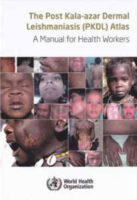Main content
This manual or rather a photo atlas – is a very practical clinical aid in the diagnosis of the neglected and complex dermatological condition of Post Kala-azar Dermal Leishmaniasis (PKDL). PKDL is a common complication of visceral leishmaniasis (VL, or kala-azar), and is seen mostly in countries in East Africa, particularly Sudan, and in southern Asia.
The neglect of PKDL, both from a clinical and an epidemiological point of view, is partly caused by the difficulty in recognizing PKDL and making a definitive diagnosis. Microscopy of skin smear or biopsy generally has a low sensitivity. Therefore, diagnosis is usually made clinically by the combination of the typical rash, its distribution, and a previous episode of VL. Especially for health workers in remote endemic settings without access to dermatological expertise this remains a major challenge, because the clinical presentation varies and the list of differential diagnoses is extensive.
This atlas can help health workers make a reasonable diagnosis of PKDL based solely on clinical grounds. The authors have made a call to experts and people in the field to contribute photos, and after reviewing many thousands, they are presenting a selection of over 400 high-quality photos, covering the wide spectrum of presentations of PKDL, as well as the common differential diagnoses per endemic area. The PKDL atlas has become an attractive reference work, which will not only serve as a valuable guide to better and earlier recognition of PKDL by health workers in remote areas, but will also be a useful tool in clinical teaching.

The Post Kala-azar Dermal Leishmaniasis (PKDL) Atlas: A Manual for Health Workers
Authors:
E.E. Zijlstra and J. Alvar,
World Health Organization, 2012


















































